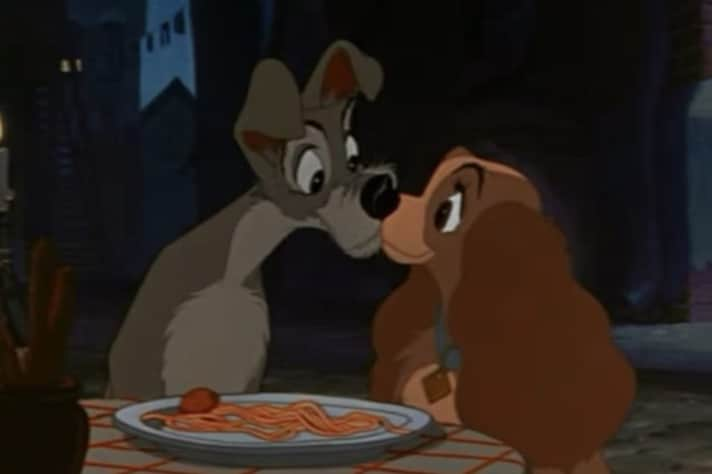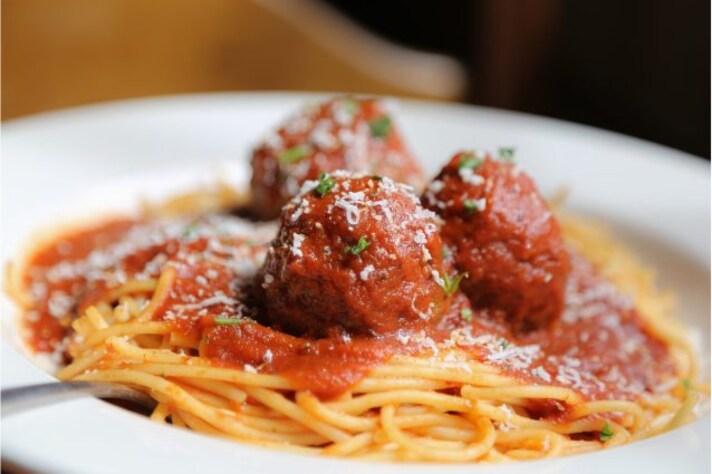The History Behind Spaghetti and Meatballs: the Symbol of Italian-American Cuisine
According to Marino Niola, one of the leading experts in cultural and food anthropology in Europe, spaghetti and meatballs are the true symbol of Italian-American culture. An identity dish that united people overseas who left to find a better fate. Let's see the history of this dish, discover its link with cinema and all the "original" Italian variants.

There are iconic dishes, wonderful in all their powerful image and one of these is spaghetti with meatballs, among the symbolic recipes of Italian-American cuisine, which has become famous throughout the world thanks to cinema and not thanks to its flavor. The seventh art has had a huge influence on this modern iconography and one of the most romantic scenes in the story features spaghetti with meatballs: we are in Little Italy and at the back of an Italian restaurant there is a small table set with the classic red and white checked tablecloth, a flask of wine that acts as a candlestick, a basket with loaves of bread and a plate of spaghetti and meatballs eaten by two little dogs, namely Lady and the Tramp.

The two lovers from the 1955 Disney movie share a plate of pasta until they stumble across the same spaghetti that will lead to a tender kiss. The background song is "Dolce dream" sung by Umberto Marcato, a perfect accompaniment for one of the most famous dishes in world's cinema. We can consider this the first approach that Italians had to the dish, given that until then only those who had relatives in America had heard of this pasta.
Where di Spaghetti and Meatballs Originate?
For many, spaghetti with meatballs is an insult to Italian cuisine. Omnipresent on American tables, they have represented a false myth of local gastronomy for a long time. In reality it wouldn't be that false: let's get there.
For many Italians, spaghetti and meatballs are an unthinkable combination and only the sweetness of Lady and the Tramp softens the abrupt relationship between pasta and balled up meat. In reality this recipe represents Italy much more than Italians might think and not only because there are many historical local dishes that are modeled on this dish. It is a cultural, identity, historical question.

Spaghetti with meatballs is the symbol of Italian emigration to the United States. The refuge of the poor people, of the Italians seeking their fortune in the Big Apple, who could afford very little and spent most of their savings on food: they brought spaghetti and canned tomatoes from home, perhaps they were the last preserves prepared before the trip. Tomatoes "known in person" as Luciano De Crescenzo said, which represented the bridge over the Atlantic between what was and what would be. It is precisely for this reason that spaghetti with tomato sauce is so important for Italians all over the world and so important to their identity abroad.
Among the many photos preserved in the museum of Ellis Island, the island on which all the immigrants landed, there are many scenes of lunches with pasta and tomatoes, testifying the value of food in the crossing and in conviviality. The meat isn't in these photos, so when do the meatballs arrive on the pasta? Only on the land. Ground meat is low cost but tasty, especially when mixed with other ingredients and made into meatballs. The Italian Americans found themselves in a vast, gigantic land, which had everything and more. They went from Italian hardships to American hardships but, as De Crescenzo once again said, "American hunger is different from Italian hunger".
Precisely for this reason, Italian Americans begun to make all their dishes abundant: as Marino Niola, one of the leading experts in cultural anthropology in Europe, explains "even in Italy there is the combination of pasta and meatballs, but here the dimensions are small compared to the Italian-American version. Spaghetti with meatballs is the symbol of the discovery of abundance".

It is, therefore, no coincidence that spaghetti with meatballs is so present in New Hollywood's films: a cinematic era signed by the descendants of those emigrant families. From Francis Ford Coppola who included spaghetti and meatballs in The Godfather, to Brian De Palma with The Untouchables, passing through Michael Cimino with The Sicilian and Martin Scorsese. In particular, the latter director dedicated many scenes to this dish: the Those Good Guys there is a whole symbolism that links food to murders; he is also present in Carlito's Way, Raging Bull and the most recent The Irishman. The most important contribution that the Oscar-winning director has given to spaghetti with meatballs is in one of his early works: Italianamerican, a documentary in which, through the history of his family, he tells the story of Italian Americans. There is an emblematic passage, a phrase from his mother Catherine: "No food, no home, we barely slept under the bridge… and despite everything we are Italian Americans! And we are here". The documentary is almost live and Scorsese follows his mother during the chores, including cooking. The lady actually prepares spaghetti with meatballs, she explains how she makes them and after the credits there is even her recipe.
Speaking of the recipe: the first written recipe for spaghetti and meatballs dates back to 1922, published by the National Association of US Pasta Manufacturers. A very simple thing, practically identical to today: spaghetti, tomatoes, meatballs the size of baseballs and an abundance of parsley, that's all.
Spaghetti With Meatballs Variants in Italy
So were spaghetti with meatballs an invention of Italians who emigrated overseas? Yes and no: the size and percentage of meat in the meatballs is certainly their invention; in Italy the economical situation of the weaker groups between the 19th and 20th centuries was dramatic to say the least, so meat consumption was at an all-time low. In general, however, the idea of this dish was already present in the country, especially in the South.
In Abruzzo, to begin with, spaghetti alla chitarra is made with pallottine: a square-section pasta, about 30 centimeters long, topped with beef or lamb meatballs in sauce which enrich the egg pasta. Typical only of the city of Teramo is the timballo made with scripelle, a variant of Neapolitan-style crespelle (remember that Abruzzo was under the Borbone's influence until Italy was unified): it is a kind of seasoned crèpes with ragout of mixed meatballs, which are first fried with herbs and then possibly boiled in the sauce. The relationship between this dish and Campania is profound because it combines crepella with Neapolitan lasagna, a dish that combines egg pasta and meatballs. The dish, traditionally prepared for Carnival, has a "cousin" in Calabria: here the meatballs are not placed in baked pasta but fried and then boiled in tomato sauce, served as a condiment for underwire pasta. Even in the famous Neapolitan rice sartù, in addition to eggs, peas and mozzarella cheese, there are meatballs.

In Apulia we find two other examples regarding the combination of pasta and meatballs: pasta seduta and maccheroni all'azzese. In the first case it is a soup in which the meatballs flavor the vegetable broth for a main course that is very reminiscent of the dumplings made in Trentino Alto-Adige; in the second case it is a real pasta with meatballs, with broken ziti, tomato puree, cheese and fried meatballs. Even in Sicily we can find a version of spaghetti with meatballs, very similar to the American one. The Sicilians didn't focus much on the pasta shape, they used what they had, in fact in many ancient recipe books you can find ziti, while in others spaghetti. The meatballs are much smaller than those overseas and with a mix of pork and beef.
Of all the recipes mentioned, we must never forget a fundamental assumption: meatballs in history were born as a recovery dish and in fact almost all of them have a very large percentage of bread inside, up to the cheese and egg balls from Molise and Abruzzo, which are almost entirely made of bread. It is no coincidence that all the recipes for meatballs and pasta are from Southern Italy and affect all regions except for Basilicata (which features a bit in Campania and a bit in Apulia among pasta dishes with meatballs). Most of the emigrants came from the South: these people found themselves and their land in a simple dish of pasta with meat and passed it down to future generations; finally, it came down to us through cinematographic art. Spaghetti with meatballs is often an "insulted" dish in Italy, one of the examples of how Americans distort the world-famous cuisine. But this is not the case: it is an iconic, representative dish, very important for the identity of Italian abroad and also very good.
;Resize,width=767;)



